















WLorenzo Diaz
Buisness
Development
lorenzo@localbreakmagazine.com
ith spring in full swing and everything coming back to life, it feels right to dedicate this issue to a man who had more than a few reinventions of his own—and helped shape the high-performance surfing we see today.
I’ll never forget when Mike Hynson called me about sixteen years ago, asking me to test one of his new boards. I figured he’d hand me one of his classic longboards, but instead, he pulled out a 5’5” shortboard—wide and flat. I laughed and told him, “I don’t think I can ride shortboards anymore,” after spending the last two decades longboarding at San-O. Mike just grinned and said, “Of course you can—it’s got plenty of volume!” If a legend like Hynson said I could do it, who was I to argue? From the first wave, I was hooked—it ended up being one of the best sessions of my life. I feel lucky to have spent time with Mike and his partner Carol. He was one of those rare, larger-than-life characters—rebellious, innovative, and always pushing boundaries.
Hope you enjoy this issue; also featuring artist Andy Davis, Duran Barr and his Surf Academy, freesurfer Kira Crage, and much more. I hope the articles resonate with you in a Rebel kind of way.
Until next issue, see you in the water!
PUBLISHER & EDITOR
Elaine Brodie
CONTRIBUTING WRITERS
Lorenzo Diaz
MJ Hessert, DO, MPH
Breanna Luke
Sean Mattison
Donna Jost
Joe Goyos
BUSINESS DEVELOPMENT
Lorenzo Diaz
CONTRIBUTING PHOTOGRAPHERS
Andres Weishaupt
Lance Smith
Nolan Van Bruggen
Vandielle Dias
Fernando Cruz
Brayden Rudert
COVER PHOTO CREDIT
Lance Smith
GRAPHIC DESIGNER
Willie Daniels
ADVERTISING INQUIRIES
Elaine@localbreakmagazine.com
Lorenzo@localbreakmagazine.com
EDITORIAL INQUIRIES
858. 774.246 7 elaine@localbreakmagazine.com
PHOTO CREDITS
Hynson/Merryweather
Private Collection
Bob Bagley/Bruce Brown Collection
Bruce Brown Collection
ADDRESS Carlsbad, California



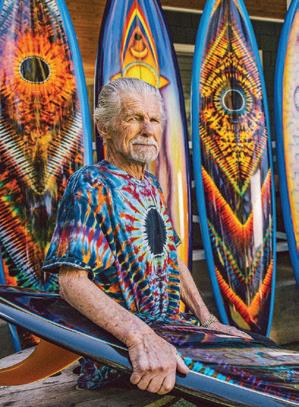



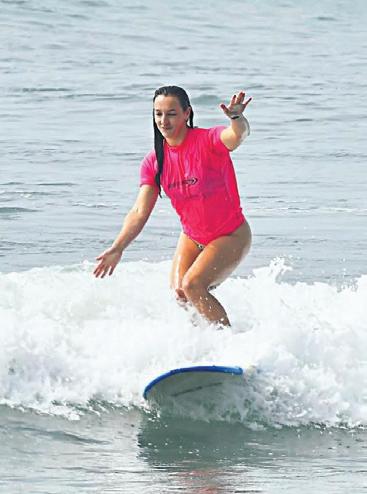

BY LORENZO DIAZ
Eric Franklin, President of The Pendleton Surf Club, is a dedicated military service member and lifelong surfer, Franklin leads a club that brings together active-duty personnel, veterans, reservists, and their families through a shared love of the ocean. More than just a surf crew, the club is a tight-knit community where military surfers connect, support each other, and give back through events like surf therapy for disabled veterans and mentorship programs for kids with disabilities.
The roots of The Pendleton Surf Club trace back to the late 1990s, when a few military surfers started meeting up at DMJs and Church, two of the best breaks on base. What began as informal surf sessions quickly grew into a movement, drawing in more and more surfers looking to share the stoke. Over the years, the club evolved from casual meetups into a full-fledged organization, hosting all-military surf contests, organizing volunteer events, and creating a nationwide network of military surfers. Today, the club has members across the country, an active online presence, and even its own apparel sales, helping to fund its mission.












At its core, the club is built on four key values: Honor, Respect, Dedication, and Fidelity. Members are encouraged to honor the sport of surfing, live with integrity in and out of the water, and always respect their fellow surfers, the ocean, and the waves they ride. Dedication plays a huge role, whether it’s improving their own skills, mentoring others, or giving back to the community. Finally, fidelity—loyalty to fellow surfers, veterans, and families— ties everything together, ensuring that the bond between members goes beyond the surf.
With 25 miles of prime coastline and some of Southern California’s best waves at their doorstep, club members have no shortage of opportunities to get in the water. The club hosts monthly surf meetups at local breaks on base, along with quarterly gatherings at a local restaurant in Oceanside, where members can share stories, connect, and plan future events. In addition to surf contests and community outreach programs, members also participate in parades, charity events, and just about anything that keeps the surf culture alive.
No matter their skill level, every member of The Pendleton Surf Club brings something unique to the lineup. Some are just learning to paddle out, while others have been riding waves for years. But at the end of the day, it’s not about how good you are—it’s about showing up, sharing the stoke, and being part of something bigger.
Whether you’re stationed at Camp Pendleton or just passing through, if you’re a surfer in the military, this is your crew. Grab your board, hit the lineup, and see what The Pendleton Surf Club is all about.
Website: thependletonsurfclub.com
Instagram: @thependletonsurfclub

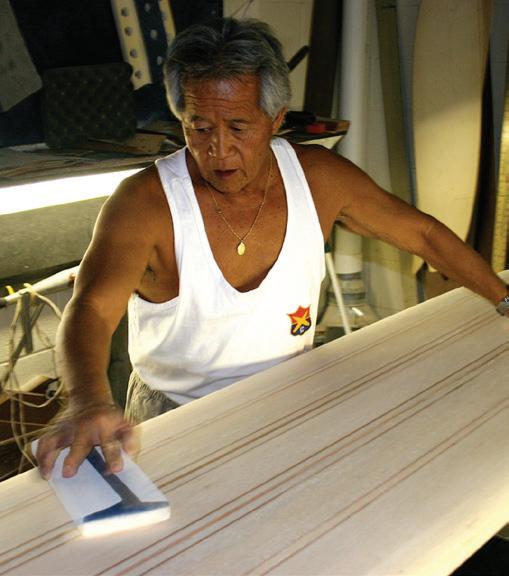


BY LORENZO DIAZ
After I caught my first wave nearly 50 years ago, I’ve been lucky enough to ride hundreds of different types of surfboards from a 4’11” Speed Square by Bing to a 12’2” Glider by Skip Frye and everything in between, my first wave ever was on a hollow 5’6” single fin that had a cork on the deck that kept popping out. My second was on a heavy log that I couldn’t turn and drove it straight into the beach. The strangest boards I have ridden were an Aluminum skinned twin fin from France, and a glassed cardboard surfboard from a shaper in San Clemente. I never turn a board down, after watching Kelly Slater surf a door, I will say that they are all surfable.
Fast forward to now, a local company that I’m digging on and is leading the charge on different and better ways to build a board is Surftech. The results are incredibly consistent, sustainable and durable surfboards that perform exceptional.
Initially they had a bad stigma attached to this type of manufacturing known as “Popouts”. Well, that stigma is getting wiped clean. The lineage of shapers vouching for and jumping on board with Surftech is deep, Surftech has collaborated with the world’s best shapers like Donald Takayama, Gerry Lopez, T-Patterson and Channel Islands to name a few. This design method makes high-performance boards accessible to surfers of all skill levels. More than three decades after introducing Tuflite—a technology that revolutionized surfboard construction— they followed up more cutting-edge constructions below:
Tuflite – A lightweight yet ultra-durable composite construction featuring an EPS core, multiple fiberglass layers, and epoxy resin for a lively, responsive ride.
Dual-Core – A hybrid design merging PU foam at the core with EPS foam on the rails, delivering the classic feel of poly with the added pop and durability of epoxy.
Fusion HD – A high-performance blend of EPS and epoxy reinforced with a carbon stringer, maximizing speed, control, and longevity.
Ecoboard Technology – Sustainability meets performance with Surftech’s (NFT) Natural Fiber Technology. Flax and other natural fibers are used to reduce environmental impact without sacrificing quality.
Surftech continues to push the boundaries for surfers worldwide. Having ridden most all of Surftechs innovative constructions, my stoke and fun factor is at the highest level. From a 5’6” T-Patterson Devil Fish in Fusion HD to the 10’6” Mickey Munoz Glide in NFT, I highly recommend you try your favorite shapers board in the Surftech lineup, with over a 100 years of cumulative surf design knowledge, how can you go wrong! Find them at a surf demo near you.

BY ELAINE BRODIE
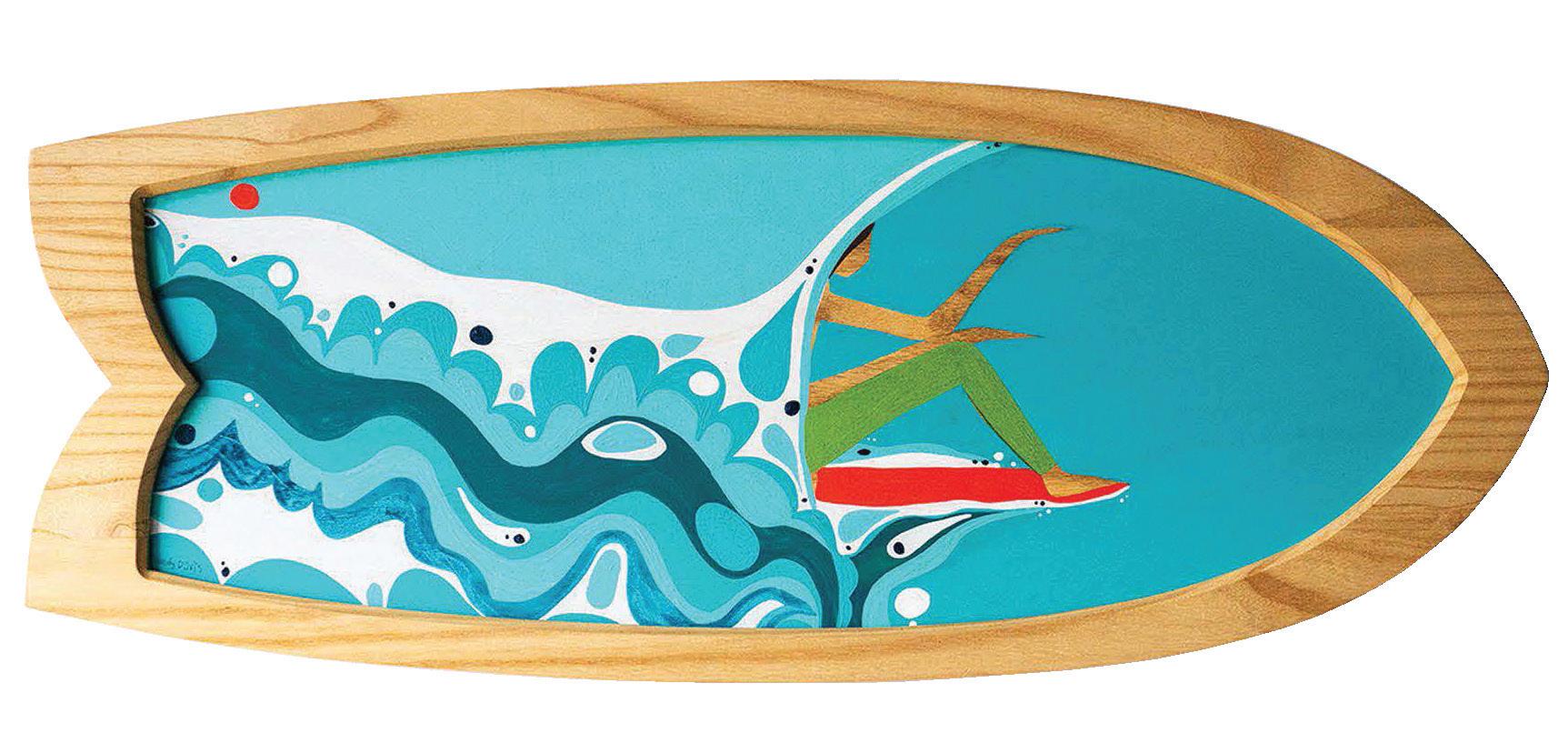
Andy Davis has always been drawn to “Dream and Play”. Fortunately, his artistic talents, strong connections and life experiences have enabled him to make it a reality through his work. His work embodies the playful, free-flowing essence of surf culture, capturing moments of joy, movement, and nostalgia in a way that resonates globally. While we proudly claim him as a local artist, his art has reached audiences far beyond North County San Diego, gracing walls, apparel, and galleries worldwide.
I had the pleasure of sitting down with Andy, an artist I’ve admired for years, to dive into his creative world. Honest, humble, and deeply introspective, Andy balances light and dark, chaos and simplicity—all of which find their way into his work. His journey as an artist is one of passion, perseverance, and an unwavering love for surfing and dreamy self-expression.
Andy grew up in North County San Diego, playing everything from baseball and basketball to water polo. School wasn’t his thing, but drawing was. His mother encouraged his artistic side, and his grandparents provided
unwavering support. Then, at age 12, he discovered surfing— and everything changed. Immersed in the surf, skate, and action sports culture of the ‘80s, Andy found a world that would shape both his art and his future.
One of his good friends is Joel Tudor. Meeting Tudor at 14 opened doors into a tight-knit surf community that celebrated style, music, and creativity. Tudor, a surf icon known for his smooth, effortless longboarding, embodied an old-school approach that deeply resonated with Andy. The two bonded over their mutual appreciation for classic surf aesthetics, and through Tudor, Andy was introduced to a world of surf films, music, skateboarding and surf sessions, and a tribe of like-minded individuals who saw surfing as more than just a sport—it was an art form. They shared an adventurous spirit and passion that fueled Andy’s artistic identity.
Instead of following a conventional path to college, Andy took a leap and started his own apparel brand, Free. Surrounded by friends launching their own creative ventures, he wanted in. At the time, Andy was working at a

surf shop. “I had no idea what I was doing, but I loved the name Free” and that’s how Andy’s clothing brand started.
With the help of his longtime friend Hago (founder of Leucadia’s Hago Tacos), who handled the business side, Free gained traction. But despite its early success, trademark and management challenges eventually led to its dissolution. Looking back, Andy remains grateful for the experience and the connections he made along the way.
As Free wound down, Andy poured his energy into art. His first big shows took place in Japan, New York, and Laguna Beach, leading to design gigs with Toes on the Nose, Roxy, and Billabong. He was among the


“
When Andy paints, music is essential to get into the creative flow. “
(CONTINUED FROM PAGE 9)
first to depict women surfing in a way that emphasized grace and style—something uncommon at the time. His work with Roxy lasted just two seasons, but his designs for Billabong lasted eight.
After his time with major brands, Andy embraced full-time freelancing. His studios in Solana Beach and now Leucadia have allowed him to collaborate with brands like Patagonia, Birkenstock, Captain Fin, and Vans. His work extends beyond clothing, covering record albums, magazine covers, murals, and more.
When one door closes, another opens. As Andy’s Solana Beach studio was closing in 2020, an opportunity with Sun Bum arose. They offered him studio space, and he created a mural on their building while designing for a new product launch. “I feel pretty lucky to have had that opportunity,” he says.
Andy’s art is a fusion of surf culture and mass media surrealism—loose, dreamy, and full of warmth. He draws inspiration from childhood influences like Charles Schulz, Dr. Seuss, Hanna-Barbera, John Severson, Margaret Kilgallen and Bill Ogden. His work captures peace and happiness, filtered through bold lines, pop-art colors, and an elegant simplicity that feels both nostalgic and fresh.
The past five years have brought a new dimension to his work—more
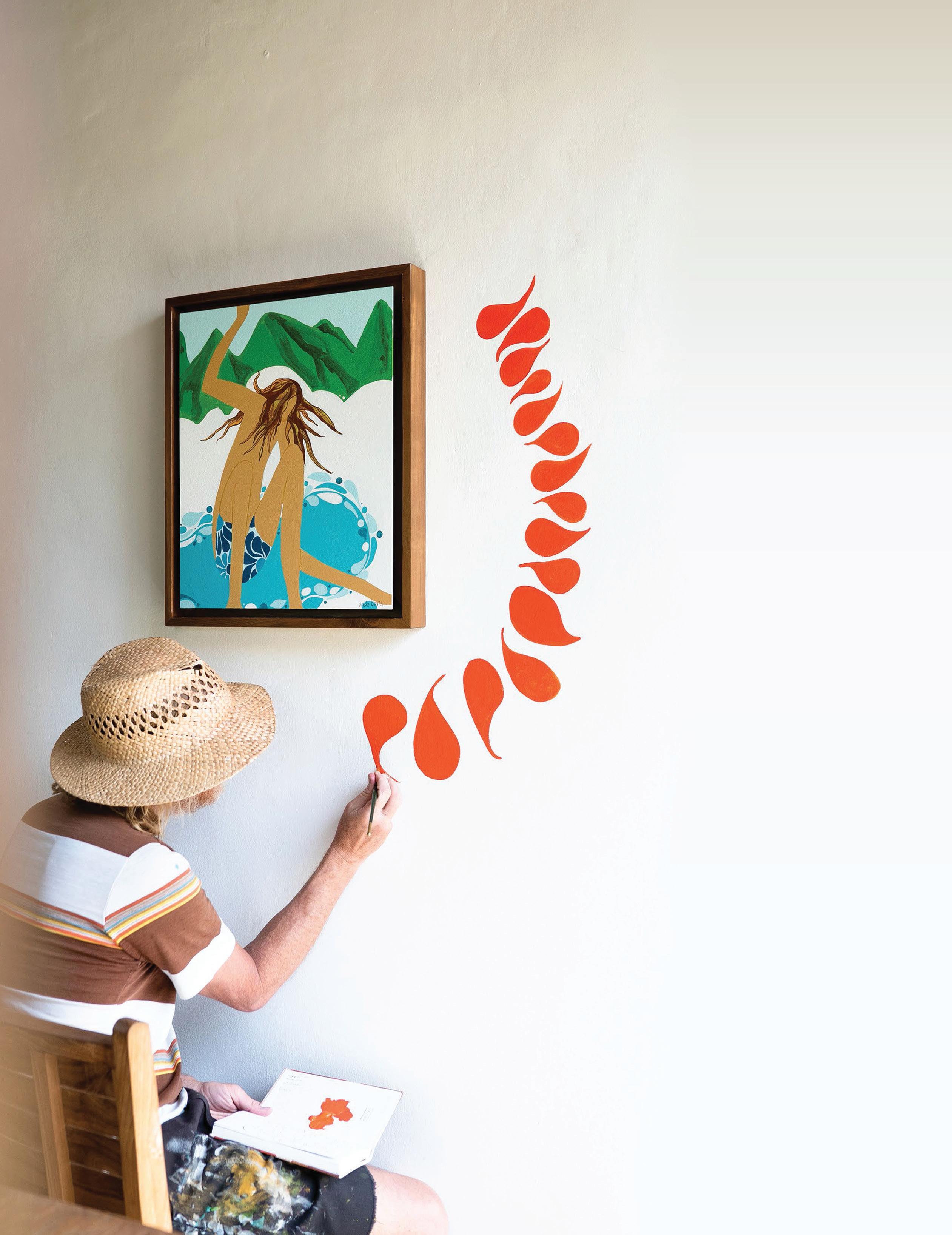
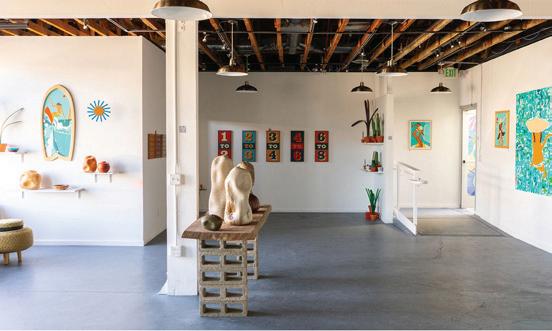



chaotic, layered, and reflective of personal transitions. “It’s hectic, but it always ends in calm,” he explains. His color palette remains light and positive, with an energy that evokes joy and resilience. Women have been a central theme in his art for over 25 years—he refers to them as ‘Alien Angels of Life’—symbols of strength, beauty, and raw emotion.
We’re lucky to call Andy a local. His legendary surf art has graced galleries from Bali to Rome, Japan to New York. But for us, all we have to do is stroll by his studio to experience his world-renowned work right in our backyard.
When asked what’s on the horizon, Andy’s answer is simple: “Painting—a lot.” His Leucadia studio is filled with paintings, drawings, and prints, all ready to find new homes. He also takes on design work, commissions, and collaborations.
Website: andydavisstudios.com

Instagram: @andydavisstudios













BY DONNA JOST
Mike Hynson did not let life pass him by. Over decades, every project he tackled he did with style, passion, and an infectious laugh.
The pioneer surfer and co-star of the classic surf flick, The Endless Summer, passed away on Friday, January 10, 2025, leaving behind a surf culture he created just by being himself—a unique and curious individual with flair who never shied away from dreaming big. Much has already been written about his passing, but the best gauge of the impression he made on the world of surfing were the thousands of posts pouring in on social media praising him for his contributions and how he affected their lives.
I began helping Hynson write his autobiography in 2003 and got the coveted job because I was the only one who could read his chicken-scratched handwritten journals. Over the course of six years, one of the most interesting things I learned about him is that he didn’t learn how to surf until he was seventeen years old. The Navy brat moved back and forth between the Mainland and Schofield Base on Oahu every two years with his family but had never been exposed to surfing. He found other things to be curious about, like infiltrating the locals’ territory behind the military base. The only one of his friends to get caught, he was tied naked to a mango tree.
When it was time to leave Oahu for good in 1952, he was crushed that his mother forbade him to bring his four grocery bags of Haleakala Dairy pogs with them on the ship to San Diego. So, as a goodbye to his friends, he climbed on top of the roof of the nearest carport and pulled two handfuls out of the bags at a time, spraying his delighted friends below.
Seven years later the seed of future legendary status was planted when the teenager rode his first wave at Crystal Pier. There was no stopping him after that. Establishing a reputation as a soul surfer instead of competing in surf contests, poking his nose into various camps up and down the coast to learn how to improve the shape of a surfboard. According to many, his was the first down rail board, but the Red Fin has always been a fan favorite. For decades, his curiosity about the sport never wavered. He continually wanted to know more.
One of Hynson’s biggest achievements didn’t start out as a dream. It just kind of fell into his lap when he met film director, Chuck Wein, in Guadalajara. Spending days together, they came up with the idea of making a movie about surfing, with him insisting that Jimi Hendrix write the score. The only problem was that he didn’t know the rock star.
That didn’t stop Hynson. He went to two Hendrix concerts



and

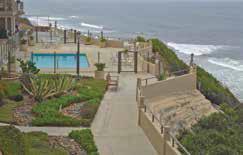
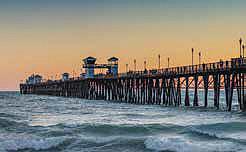


1963,
& Brother



in San Diego and tried to connect, but no luck. He flew to Oahu & learned Hendrix was playing a couple of concerts in Waikiki. He tried again without success.
Visiting friends on Maui, he and his girlfriend, Melinda Merryweather, drove to Honolua Bay. Just as Hynson took off in the curl of a wave, none other than Michael Jeffery, Hendrix’s manager, walked out on the cliff above. Merryweather ran over to him and filled him in on the film they would eventually produce, Rainbow Bridge.
Persistence and realizing that achieving a dream is not impossible were two of Hynson’s attributes. A life worth living. His passing came as a shock to friends and family. It was so fast and hard to believe. It was surreal. I prefer to say my goodbyes by imagining him standing on the roof of his garage in Encinitas, California, spraying all who loved him with his four grocery bags of pogs. Rest in peace, Michael. You will be missed.



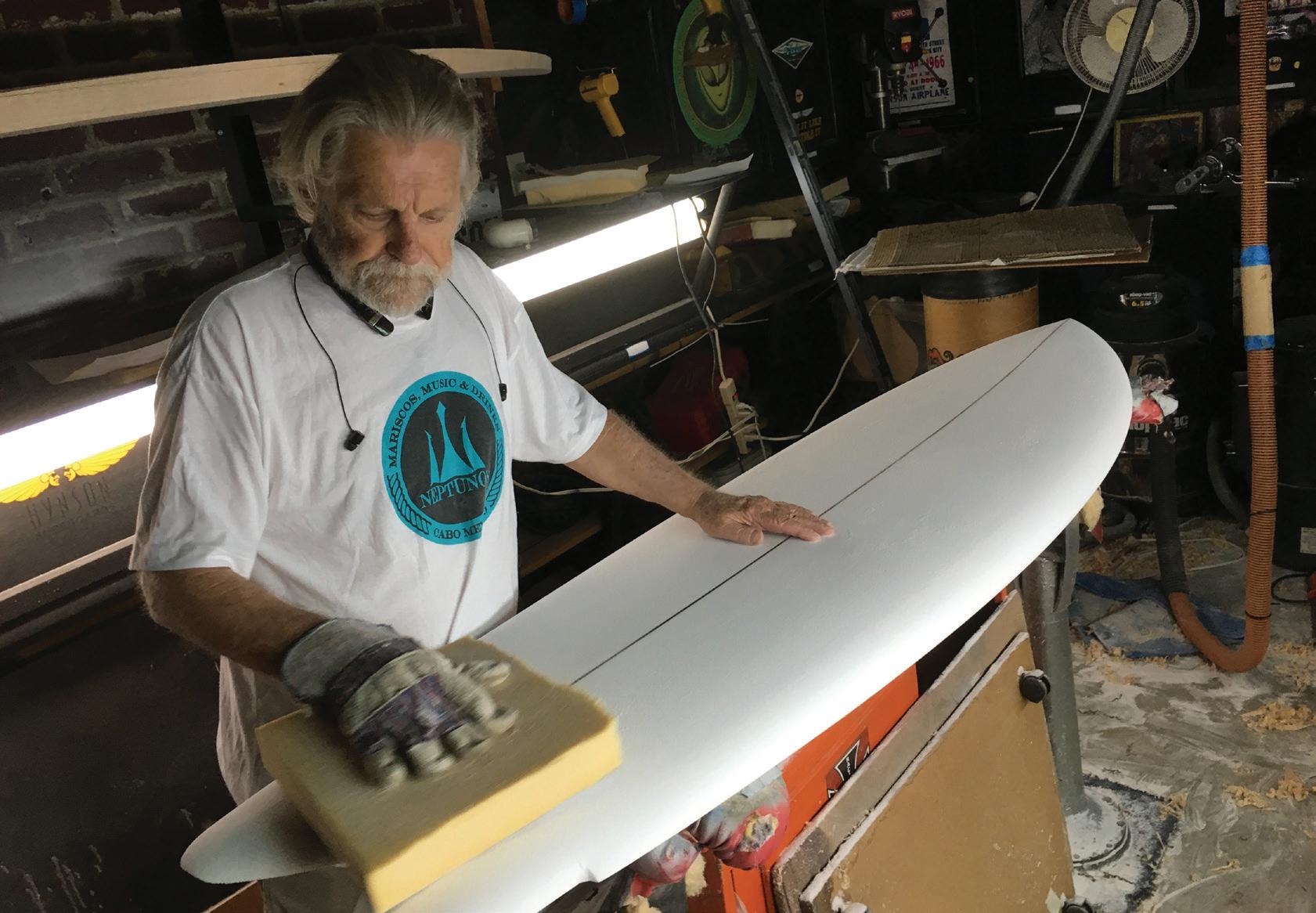
The surf world has lost one of its most iconic figures. Mike Hynson, legendary surfboard shaper, surfer, and co-star of the groundbreaking surf film The Endless Summer, passed away in January 2025 at the age of 82. His influence on surf culture, board design, and the way the sport is recognized worldwide is immeasurable.
Born on June 28, 1942, in California, Mike Hynson was the son of a U.S. Army soldier who spent much of his youth shuttling between Hawaii and San Diego County. From a young age, he was drawn to the waves, spending countless hours surfing the breaks of Southern California. Hynson’s
BY ELAINE BRODIE
passion for the sport led him to become not only an exceptional surfer but also an innovator in surfboard design.
The Endless Summer:
In the early 1960s, Hynson’s reputation as a skilled surfer began to grow. He quickly became known for his smooth style, precision, and ability to adapt to waves of all shapes and sizes. This talent caught the attention of filmmaker Bruce Brown, who cast Hynson in The Endless Summer (1964) alongside Robert August. Hynson’s charisma, skill, and easygoing demeanor helped make the movie a cultural phenomenon, bringing surfing into the mainstream and inspiring generations to take to the waves.
Beyond his on-screen legacy, Hynson was a master craftsman and visionary in the art of surfboard shaping and became known for his experimentation with board design, helping to refine the shortboard revolution. At Gordon & Smith Surfboards, he created the famous tristringer “Red Fin” model and contributed innovations like the down-rail shape that transformed board performance. His contributions to surfboard innovation enabled surfers to push the boundaries of what was possible on a wave. In 1972, Mike also developed the DolFin, a surfboard fin designed after a dolphin’s dorsal fin.
Hynson’s life was marked by periods of turbulence and transformation. In the late 1960s, he became immersed in the countercultural movement, aligning with the Brotherhood of Eternal Love and exploring alternative lifestyles. After meeting Carol Hannigan over two decades ago, Hynson began to turn his life around, finding stability and lasting companionship. Despite facing struggles and personal and professional challenges that followed, he remained a beloved and influential figure in the surfing world.
Mike Hynson’s passing marks the end of an era, but his contributions to surfing will endure. From his role in The Endless Summer to his innovations in surfboard shaping, Hynson leaves behind a legacy that shaped the sport’s past, present, and future.
Paddle out in his honor and ride a wave with the same joy and passion he brought to the surf industry. Rest in peace, Mike Hynson. Your legend lives on.





MIKE HYNSON TRANSCENDENTAL
OF A SURF REBEL
“To learn more about Mike Hynson’s legacy, check out his book co-written by Hynson and Carol Hannigan’s sister Donna Klassen Jost.”
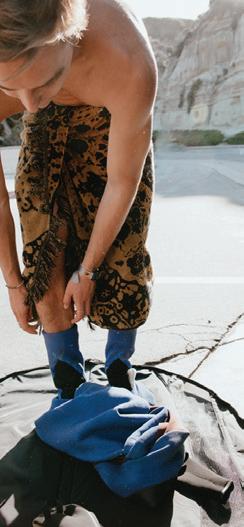
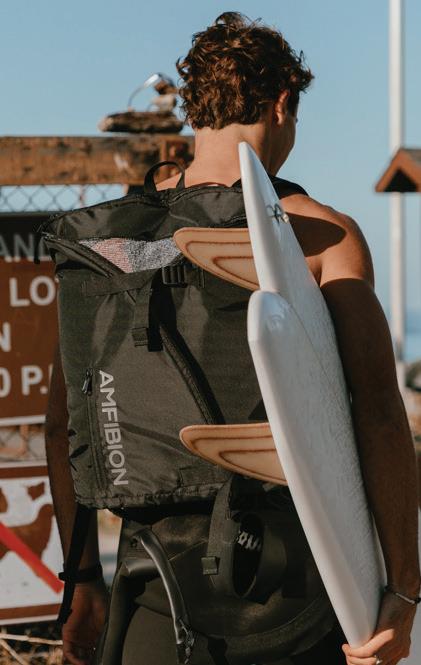




BY ELAINE BRODIE
Few people in the surf industry were as deeply connected to Mike Hynson as Sean Mattison. A former professional surfer, coach, board designer and artist, Mattison credits Hynson as one of his major influences—someone who shaped not only his career but his entire approach to surfboard design.
“I wouldn’t be in the surfboard business without him,” Mattison reflects.
Their relationship spanned decades—through collaboration, challenges, and ultimately, a powerful reunion that gave them both the chance to create something meaningful together once more. Now, as the surf world remembers Hynson’s legacy, Mattison honors him not just as a surfboard innovator but as a mentor, a creative force, and, in the end, a true friend.
More than 25 years ago, a distributor in Japan approached Hynson about carrying his boards. While Hynson wanted to focus solely on shaping, he asked Mattison to run the business. Under Sean’s leadership, they expanded beyond classic longboards and guns, introducing new designs like the Black Knight Quad and the Twinzer and others to the lineup. The business thrived, though working with Hynson
wasn’t always easy. Their partnership lasted 10-12 years before they parted ways—not under the best circumstances.
Mattison continued on and developed his successful Von Sol Surfboards, a high-performance alternative surfboard line. It was nearly a decade of working alongside Hynson that provided the foundation of knowledge he would later draw from. Fin design, wave dynamics, and functional design principles—lessons passed down from Hynson—became an integral part of Mattison’s work.
Just a little over two years ago, Mattison brought one of Hynson’s iconic downrailers over to Hynson’s house. Mattison was hoping to document its history and have Hynson sign the board. Instead, Hynson looked at him and said, “We should make more of these.”
Mattison hesitated—until months later, a discussion with Bob Hurley gave him a push. Hurley said, “You gotta do it.”
That moment reignited something between them. This time, their collaboration wasn’t just about making boards— it was about doing it over the top. Hynson’s downrail


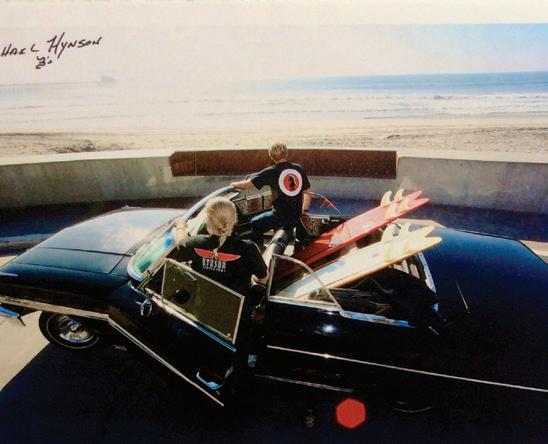
design revolutionized surfing, making waves once thought impossible, possible. It influenced an entire generation of shapers, including Gerry Lopez and others. And it was also the beginning of a revolution or relationship between surfboards and art. Working with Hynson not only rekindled a business relationship—it enabled Mattison to grow as an artist, embracing airbrushing and creative board designs in ways he had never explored before.
As their renewed partnership deepened, so did their friendship. Just before Christmas, Hynson signed a poster for Mattison, writing, “Aloha Forever.” Then, in a deeply personal gesture, he handed Mattison something truly special—his International Board Builders Hall of Fame jacket. Looking him in the eye, Hynson said, “You deserve this.”
In Hynson’s final days, Mattison was able to visit him in the hospital, holding his hand, playing jazz music, and calling

longtime friends like David Nuuhiwa and John Bredin to say their goodbyes. When Mattison left, they exchanged a look of unspoken understanding—a farewell that needed no words.
Looking back on their decades-long journey, Mattison reflects:
“I am honored that we reunited. It wasn’t just about building boards—it was about rebuilding our friendship. What we created together in those last few years was something special. The boards, the memories, the respect—it all lives on.”
Aloha Forever, Mikey. - Sean
Help Mike Hynson’s partner, Carol in her time of need. Scan the QR-code for details


BY MJ HESSERT, DO, MPH
Oto major traumatic brain injury (TBI). Prevention of brain injury and chronic traumatic encephalopathy (CTE) is the most compelling reason for helmet use. Lesser-known side benefits of helmet use include retaining heat in cold water, prevention of surfer’s ear (for helmets that cover the ears), sun protection and the ability to mount a camera.
Conditions do not have to be heavy or the lineup crowded to be at risk. Even falling off in small waves can cause the board to get hurled up into the air. The only thing standing between the surfer and a board hitting them in the head is luck – or a helmet! I’ve been hit twice in the head – pretty damn hard – by my own board. Both times I was wearing my helmet. I believe it saved me from a significant concussion, if not total loss of consciousness.

BY JOE GOYOS
n Dec 3rd 2023 at Pipeline’s Backdoor on Oahu’s North Shore, professional surfer Joao Chianca dropped into a huge wave. Unfortunately, his incredible skill was no match for the wave whose bottom dropped out. Chianca free fell through the air before plunging back into the water at the nadir of the wave. No one knows for sure whether he hit his head on the reef or the board, but he was knocked unconscious and nearly drowned.
As terrible as this incident was, it encouraged greater use of surf helmets. Nowadays, it is routine to see helmeted surfers in major competitions – especially big wave competitions – as well as at your local break. Surfers wearing helmets are still a minority, but the tide is changing, similar to how helmets became standard in biking and skiing decades ago
The head is the most commonly injured body part in the sport of surfing. Many of these injuries are caused by a surfboard (the owner’s or someone else’s), however, they can also be caused by underwater hazards or the seabed itself. Skin injuries range from mild abrasions to major lacerations; brain injuries range from minor concussions
In February 2021, I had a serious surf accident resulting in an ear laceration and brain injury, leaving me with no memory of the event and a long road to recovery. I was intubated for 24 hours and hospitalized for six days at Scripps Memorial Hospital La Jolla and I am convinced that wearing a helmet would have drastically changed my outcome. Surf helmets today are lightweight, comfortable, and provide critical protection against head injuries from collisions with boards, the reef, or other surfers.
Now, I never surf without a helmet and often think about how common helmets are in snowboarding, wondering if increased awareness will lead to a similar trend in surfing. Seeing younger surfers at Pipeline wearing helmets gives me hope that more people are prioritizing brain safety.
There are many types of surf helmets, both hard and soft, with visors and earflaps and without. I recommend finding one you like and will actually wear. Surfers can be minimalists when it comes to clothing and equipment, however, this is one piece of gear you don’t want to be caught in the lineup without.
MJ Hessert is an Emergency Medicine Physician and avid (helmeted) surfer in Oceanside, CA.
BY ELAINE BRODIE

Kira’s connection to the sea runs deep. Raised in a surf-loving family, she was on a board as soon as she could stand. After moving to Encinitas at 15, she swam competitively at Torrey Pines High and later at Stanford, where she graduated in 2023. Though she competed in swimming, surfing became her true passion. “When I’m surfing, I feel like my soul is dancing,” she says. Now balancing research administration at Stanford’s School of Medicine with her love for surfing, she continues chasing waves with the same enthusiasm she had as a child.
For Kira, surfing is an art form. “Surfing can be a window to the way someone’s mind moves,” she shares. While she enjoys pushing her limits in bigger winter swells, her favorite moments come from surfing with family. One of her most cherished experiences was sailing and surfing through Northern Sumatra and the Banyaks with her parents, who now live aboard a 46-foot catamaran.
Her passion has led to new opportunities, including joining the Bing Surfboards team and Mamala wetsuits. “I’ve never had warmer or better-fitting wetsuits,” she says, grateful for the support.
Though she competed in the Super Girl Pro, Kira sees surfing as personal expression rather than competition. “Surfing is my escape from competitiveness,” she says. Her goal isn’t trophies—it’s longevity. “There are surfers in their 50s, 60s, and 70s at my local break. That’s what I aspire to.”




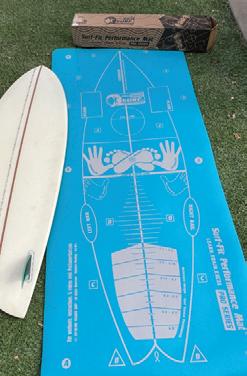





I aspire to. “ “
She dreams of surfing South America’s famed lefts and one day paddling out at Australia’s Kirra. Whether in a remote paradise or at her home break, Pipes, she approaches each session with an open mind. “Surfing is unpredictable, beautiful, and moody. You have to roll with it.”
For those looking to improve, Kira’s advice is simple: surf often and observe great surfers. “Watch how they move, position themselves, and choose waves. Don’t be afraid to experiment with boards—expensive doesn’t always mean better.”
Most importantly, she encourages surfers to embrace vulnerability. “Falling and making a fool of yourself is part of the process. Surf because you love it, because it challenges you. And if it doesn’t bring you joy, that’s okay too.”
Kira Crage surfs with the wisdom of someone who understands the ocean’s lessons: respect, adaptability, and passion. Whether she’s gliding down a perfect wave or wiping out spectacularly, she knows she’s exactly where she’s meant to be—dancing
sea.
NORTH COUNTY’S TOP SURF SCHOOL
BY BREANNA LUKE

To surf is to feel, a blessing no surfer can deny. The ones that choose to devote their time teaching this blessing are the true, unsung angels of the water. There are many surf schools in North County, filled with messengers of the ocean’s wisdom, all devoted to sharing the stoke.
Since North County Surf Academy’s creation in 2019, owner, operator, and Carlsbad native, Duran Barr has been providing lessons to students of all levels primarily out of the Oceanside Harbor Beach South Jetty. Duran Barr and his team of instructors also operate surf clinics and provide Baja California tours to share their love of the ocean with their clients.
Born in Carlsbad and raised by legendary surfer and shaper, David Barr, Duran uses his platform of the sea to coach. Whether its coaching local youth talents, training adaptive athletes, to U.S or World International Surfing Association (ISA) gold medalists, or chasing swell surfing and filming around the globe, you can trust Duran Barr is truly ‘out there’. Even on land, Duran finds a way to stay among the motion by being a partner of Oceanside and Carlsbad seafood restaurant, Shoots Fish and Beer.
Tyler Meppen, a four-year surf instructor at North County Surf Academy explains their success. “We have a team of seasoned instructors, top-quality equipment, flexible scheduling, and customer service is our main priority. We are very eager to teach, and it is always a fun time with us”. When it comes to Duran Barr as a boss Meppen claims, “He is very motivated. I respect that he likes to hustle just as hard as we do and that he charges big waves on his free time.”
Thirteen-year-old ripper and barrel chaser, Walker Hawes, was mentored by Duran Barr on a surf trip to Playa Zicatela Mexico, shares that Duran has helped him progress and go outside his comfort zone. Smart, talented, and nice are the words Walker Hawes uses to describe Duran Barr as a mentor.
Novice or expert, us students of the sea understand that it is proper etiquette to not only appreciate mother ocean for her greatness but to also show appreciation to the ones who help us gain the experience we crave.

“BEST SURF SCHOOL OF NORTH COUNTY SAN DIEGO, 2024”
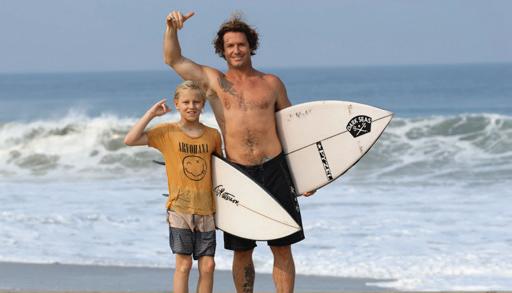
Hawes mentions, Coach Barr “helped me surf the biggest and best waves I’ve ever been in.”

NORTH COUNTY SURF ACADEMY
Surf lessons, coaching, camps, rentals Call 760-643-7160
northcountysurfacademy.com
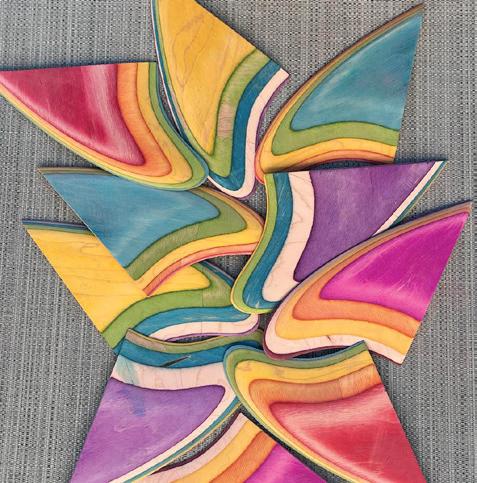


Danny DiCola may not be a household name in surfboard shaping, but that’s fine by him. Born in Leucadia, California, in 1984, he and his brother, Chris, spent every moment at the beach.
His first taste of shaping came from watching his friend’s dad Gary Goodrum craft boards in his backyard. Goodrum would give them foam scraps to carve into tiny surfboards, which he’d glass for them.
DiCola didn’t shape a real board until 2010. Focused on a skateboarding career, he joined a North Shore trip with Alex Horn of OJ Skateboard Wheels, where they shaped their own boards under the guidance of Milford Barnes, a tattoo artist taught by Jeff McCallum. The process hooked him. Soon, he was shaping anywhere he could—sanding hot coats in his van behind grocery stores and doing color work in dirt lots by Terra Mar.
Determined to refine his craft, DiCola sought mentorship from Hall of Fame shaper Hank Byzak. Known for his brutal honesty and unmatched precision, Byzak pushed DiCola to his limits. “The fins are too far back!” Byzak would yell, or he’d grab the board and immediately point out asymmetry in the rails. But DiCola kept at it. One day, he brought in a new egg shape, and Byzak finally said, “There’s nothing wrong with that surfboard.” Coming from Hank, that was huge.
BY LORENZO DIAZ
With Byzak’s approval, DiCola shaped rent-free in his shop— alongside John Kies and Steve Clark—under one condition: his boards had to carry the Pure Fun logo. He refined his craft further, shaping Aipa stings, mini-Simmons-inspired boards,

and a fish design that drew attention to his fins. His brother Chris became his test pilot, riding the same egg shape over and over until it was dialed in.
Today, DiCola Surfboards is known for performance-driven boards and signature skateboard-fin designs, crafted from repurposed decks. His shapes, built for San Diego’s yearround waves, keep customers coming back.








